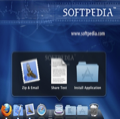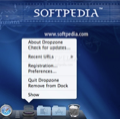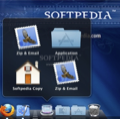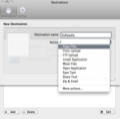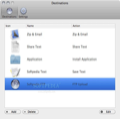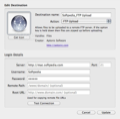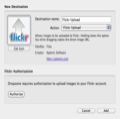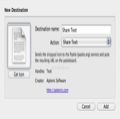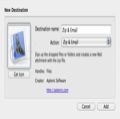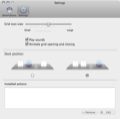Dropzone provides you an elegant method for quickly solving redundant tasks. It actually suggests you a sort of automation process that can optimize your daily work routine and eliminate some of the repetitive actions, that normally occur when having to work with the same apps on a regular basis.
Dropzone not only lets you define your own collection of tasks for the apps you use more frequently but it also comes with about ten useful suggestions. And, if you want to discover more, you can always go to the Dropzone's website to browse its entire collection of actions.
Furthermore, after you have personalized the default actions’ behavior, so that they suit your own user needs, all you have to do left is to drag-and-drop the files or apps that you want to process onto the appropriate action’s icon, displayed in the Dropzone’s grid. The grid stays at your fingertips, as it can be opened with a single click on the Dropzone’s icon, added in the Dock.
The Looks
After installation, Dropzone will display a blue icon, resembling with a stack of circles, in your Dock. When clicking on it, a small grid will pop up. In this pop-up users can see three types of actions, added by default: Zip & Email, Share Text and Install Application. In accordance with your needs or preferences you can easily add in the grid new destinations that use customized actions
To view all the supported types of actions you have to select the Preferences option from the right click menu. This action will open the so-called Destinations window, where you will be able to see a list with all the actions defined up to the moment. The Destinations window also includes some buttons with intuitive names for performing basic actions.
When adding a new action or editing an already defined one, you have to fill in a bunch of fields, that are relevant for the respective selected item. In all cases, you are required to choose a destination name, an action type from a drop-down list and a relevant icon. The icon can be generated automatically or added by drag-and-drop.
The Settings tab, that is also accessible from the Preferences window, lets you modify the grid icon size and specify the Dropzone’s position in the Dock. What is particularly nice and useful in this window is that it also allows you to remove user installed actions or view and edit the source code of the respective actions. This way, if you have the know-how (Dropzone is using a ruby based scripting API), you can easily create new actions.
The Works
Dropzone comes with a default set of actions, including the following ones: Copy Files, Flickr Upload, FTP Upload, Install Application, Move Files, Open Application, Move Files, Open Application, Save Text, Share Text or Zip & Email.
To use any of them you must create new destinations in order to give them a specific meaning. For instance, when you want to add a FTP Upload action, you have to complete a text field for the destination name and a bunch of other five text fields with login details. If you don’t complete some of them (such as the server path) Dropzone will not let you go further.
This flow of actions is intuitive, since in this particular case, for making Dropzone understand where you want it to upload the files dragged-and-dropped into its grid, you have to first give it a correct server path.
What is nice about every editing window is that it includes a short description of the type of action that is currently being edited and points out exactly the type of files you should drag-and-drop over an destination icon in the Dropzone's grid.
This info might be useful in case you forget what type of file you should drag-and-drop over an action's icon, while you are in the Show mode and you have to quickly come back to a particular editing window to check the Handles field.
In other words, some action names might seem a little bit confusing or not so intuitive at the first glance. Such an example might be the Share Text option. If you open the Edit window and you pay attention to the explanatory text you will easily discover that if you want to make such an action work you have to simply select a piece of text and drop it in the Dropzone grid, on the icon that matches the Share Text action. As a result to such an action, Dropzone will send the text to an online service, called Pastie, and put its URL on the pasteboard.
All seems clear and logical after you read the summary associated with this action but if you don’t you read it carefully you might think, for instance that, such an action allows you to also drag and drop text files into the grid and share them through whatever other method.
This is why, we consider that, the Handles label, included in all the editing windows, is pretty useful: again, it simply reminds you the type of item you have to paste into the Dropzone grid for making a particular type of action work.
Another example of a situation, when you might not understand at the first glance, the whole cycles of actions performed by Dropzone in the background, is the Zip & Email action. In its case, besides the fact that it archives a dropped file or folder and opens your default e-mail client, Dropzone also creates a new mail attachment and displays it directly in a composing window.
Again, this workflow might seem quite logical, but you will fully understand the true action's behavior only after you use it at least once, and not solely by looking at its name.
The same observation applies to actions like moving files or uploading pictures to Flickr. The name of the second one is quite intuitive but the fact that if you don’t set your Flickr account properly, you don't receive any error message and the action won’t have any effect, is not.
The nice thing in this situation is that, you only have to type in your Flickr credentials once, namely in the editing window. After you have done that and you managed to go through all the steps that are required for marring your Flickr account with Dropzone, uploading a picture to Flickr will be a piece of cake.
To be more exact, all you will have to do, will be to drag-and-drop the picture you want to upload to the icon associated with the Flickr upload action, displayed in the Dropzone's grid, and the app will do the rest of the job for you.
But, my favorite default actions are, by far, the one that help you launch and even install applications. Especially the second one is quite brilliant. Here is a short summary of the way things work in its case: when you drag-and drop a dmg file onto the icon associated with the Install Application action, in the Dropzone's grid, the app will mount the disk image, find the application inside, copy it to your Applications folder, launch it and, most important, eject the disk image and move it to the Trash for you.
Such an automation of a package installation process is really great because it spares your time and cleans the clutter on your desktop. Regarding the Dropzone customization options there is not much to say. Dropzone aims to provide its users a nice and clean interface, with as few buttons and controls as possible. That is why, probably, the developers have only included in the Preferences window a scrollbar for customizing the size of the grid icons, a check box for specifying whether you want or not Dropzone to play sounds on specific actions, and the possibly to change the position of the icon added to the Dock.
The Good
In addition, Dropzone is designed with a sense of simplicity and usability in mind, in the spirit of Mac OS X’s applications. It even looks like one of the apps that comes with the system and integrates perfectly with the Dock.
The Bad
The Truth
But, besides the fact that it has a nice looking interface and it lets you give your colleagues the impression that you are a Mac guru (who can switch windows and deliver tasks with the speed of light), Dropzone can actually optimize your work or at least make you perform some basic, repetitive actions faster.
 14 DAY TRIAL //
14 DAY TRIAL // 